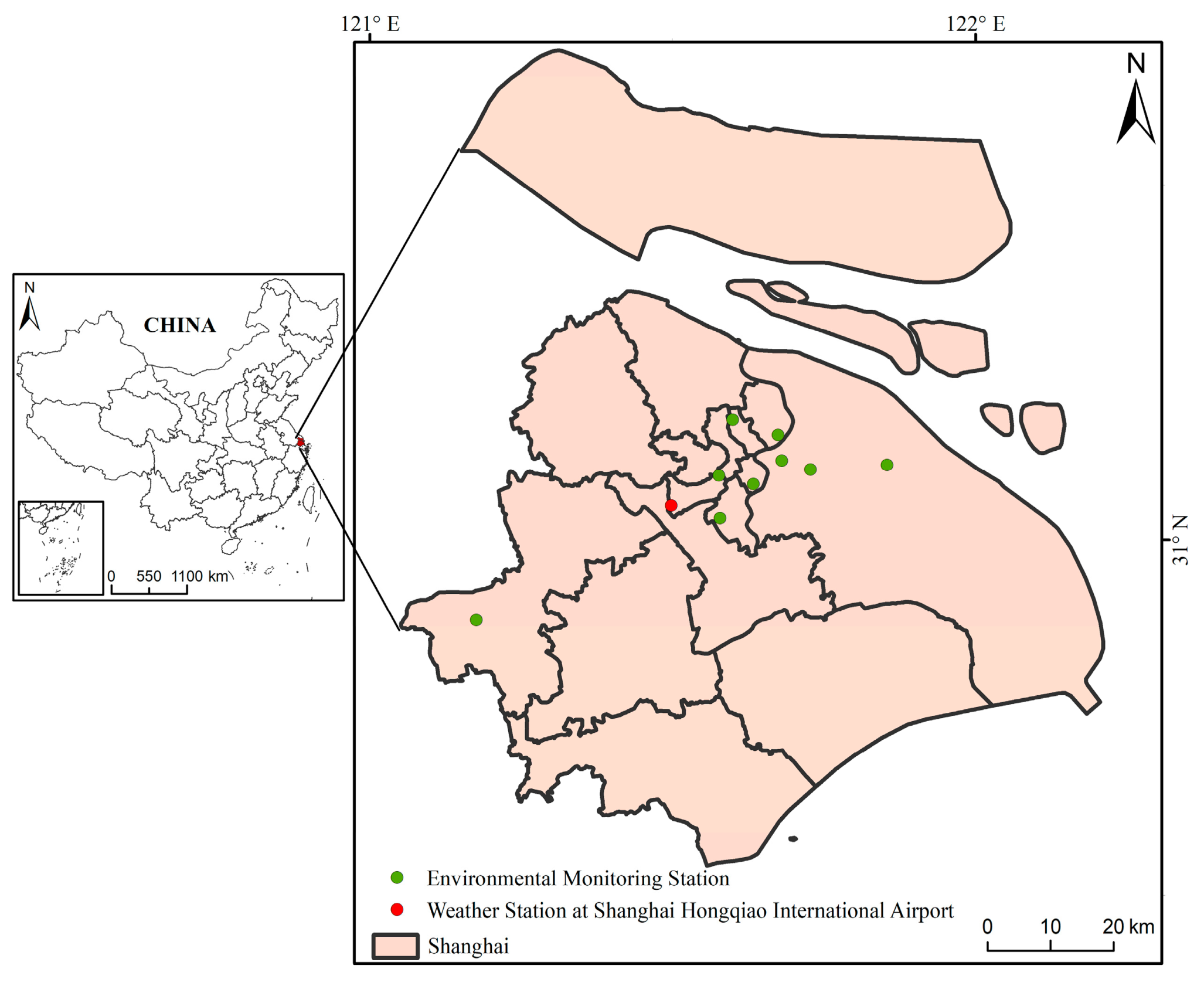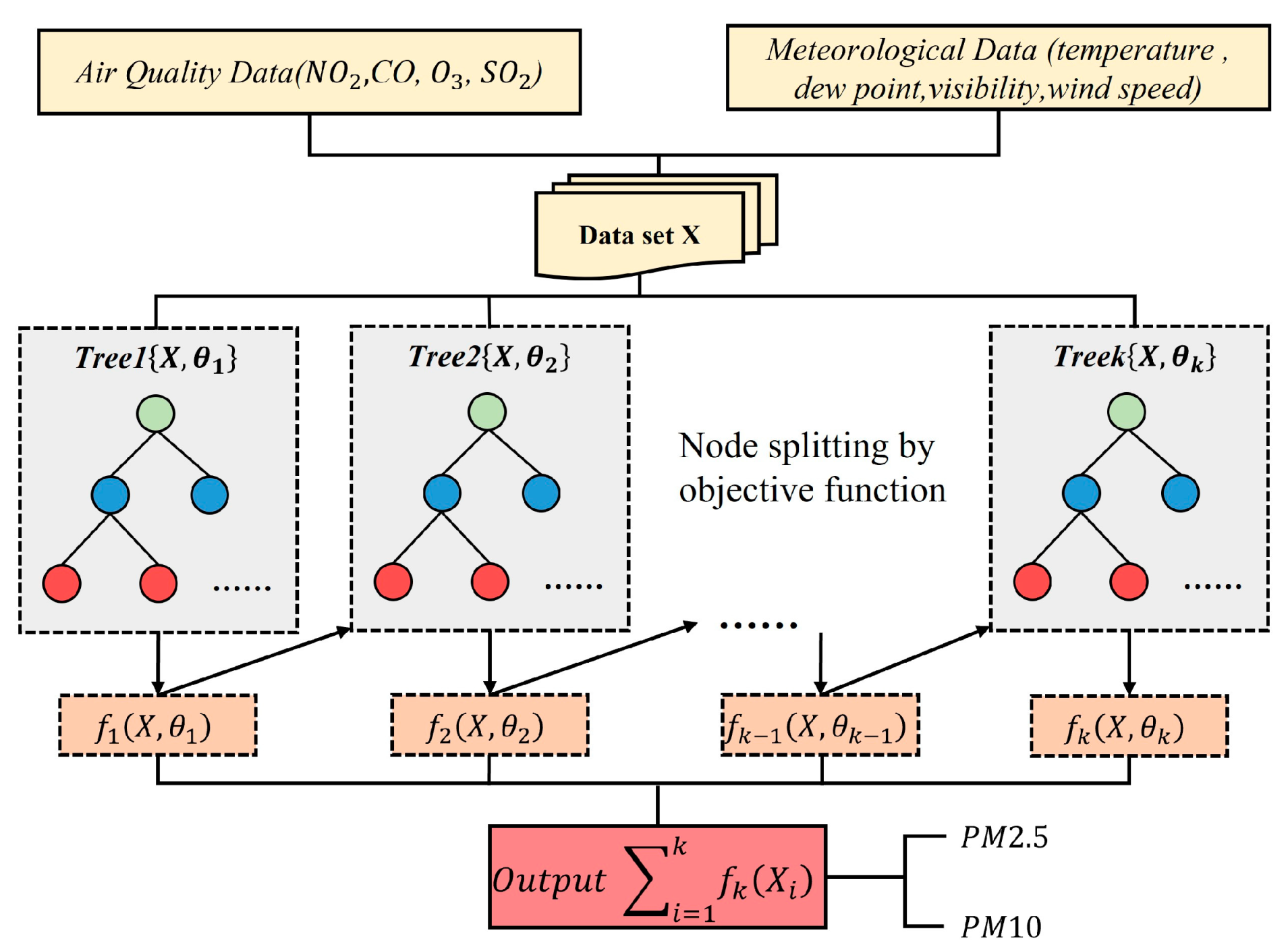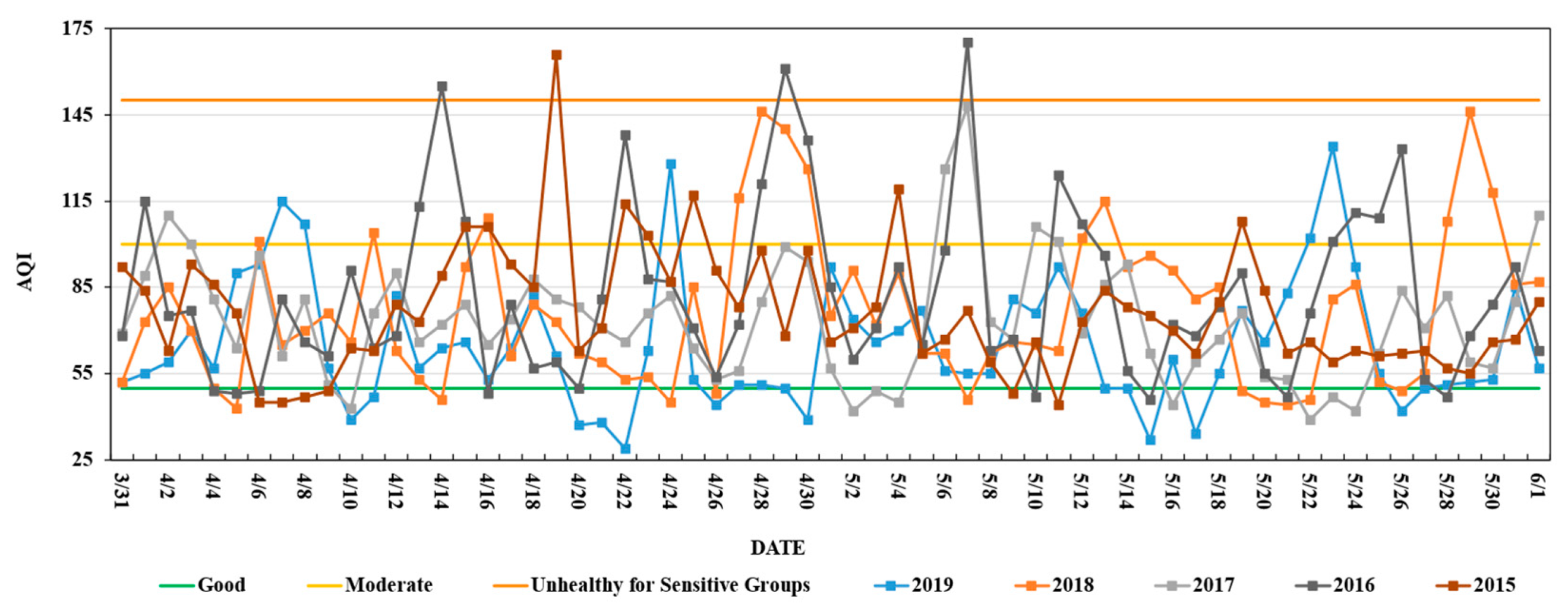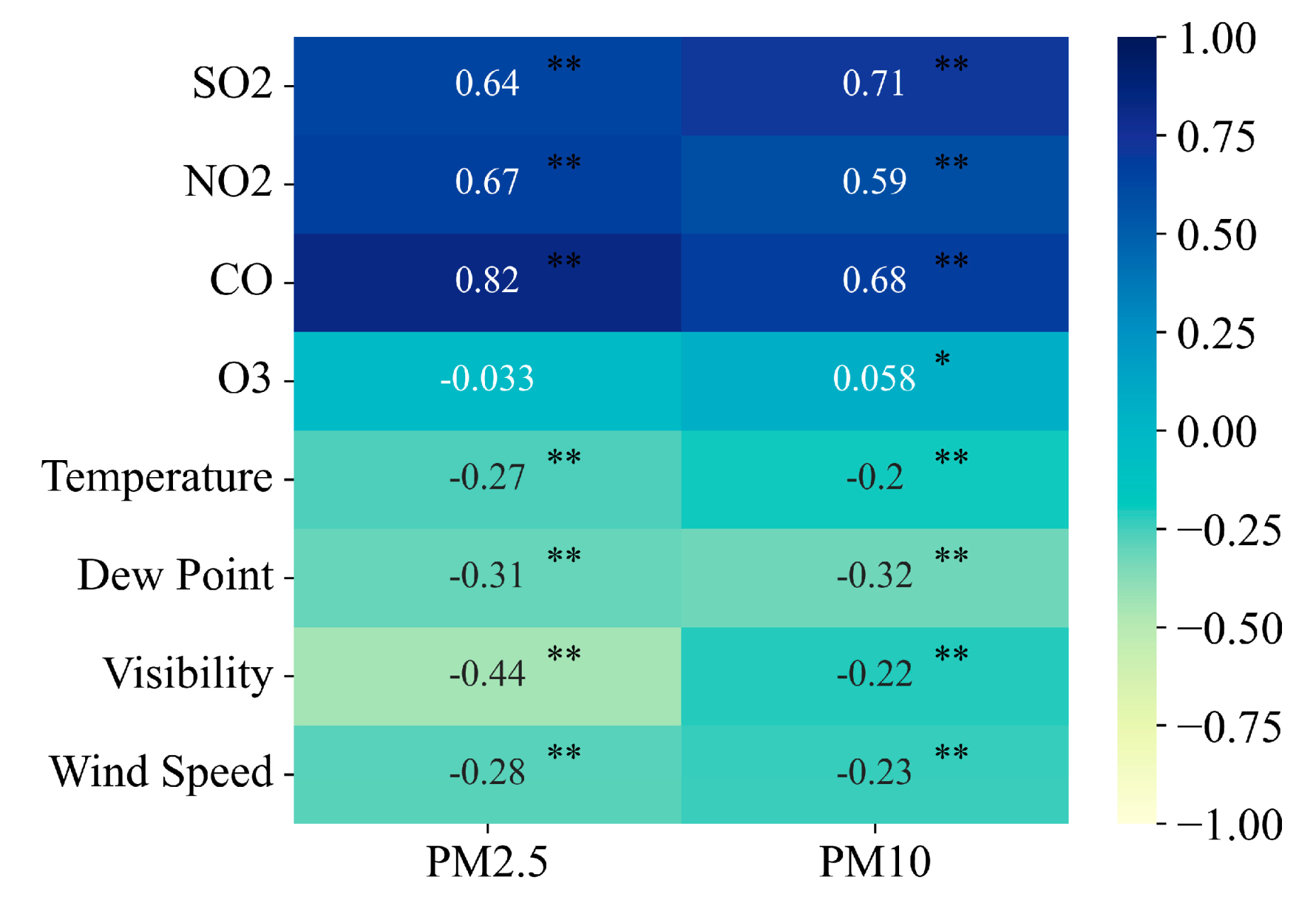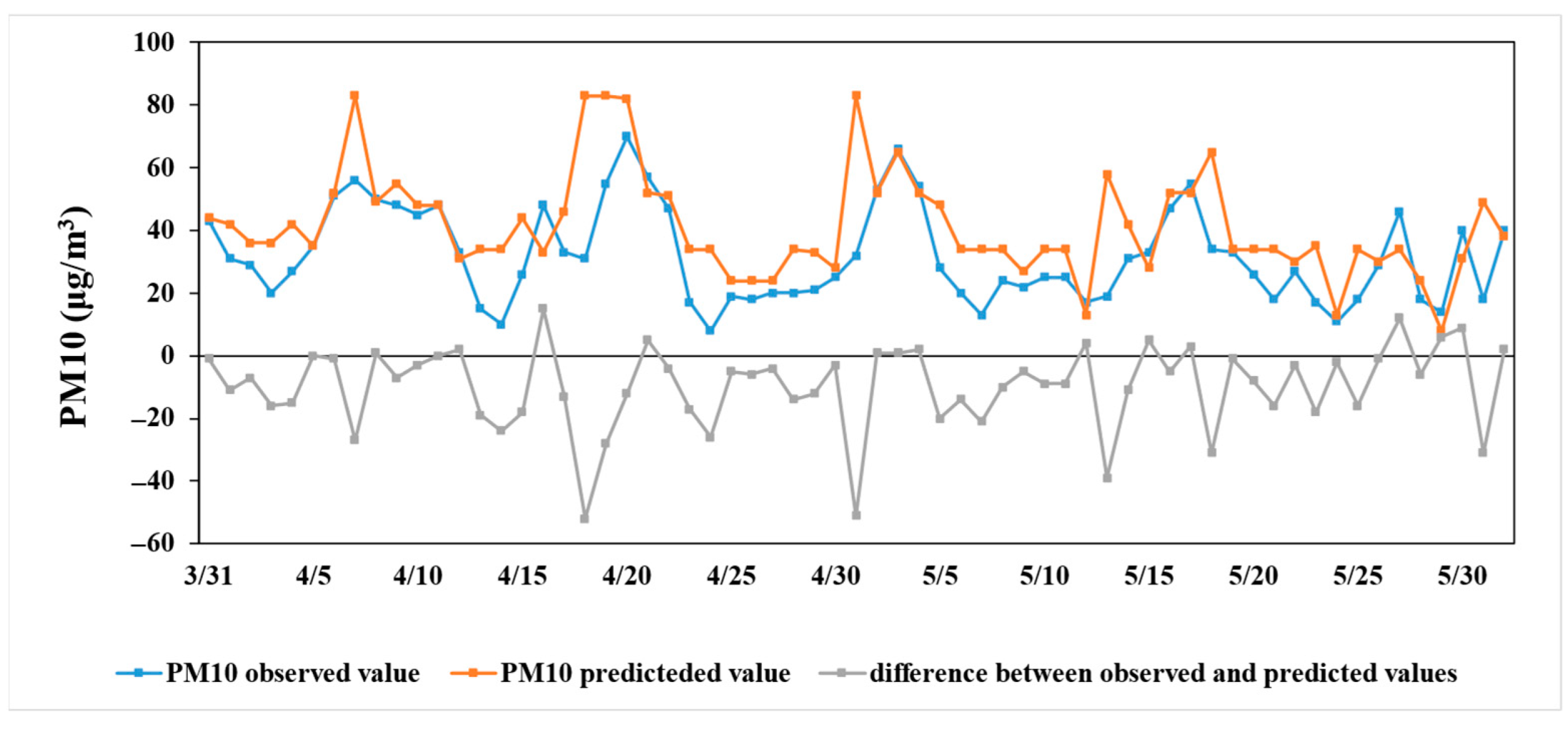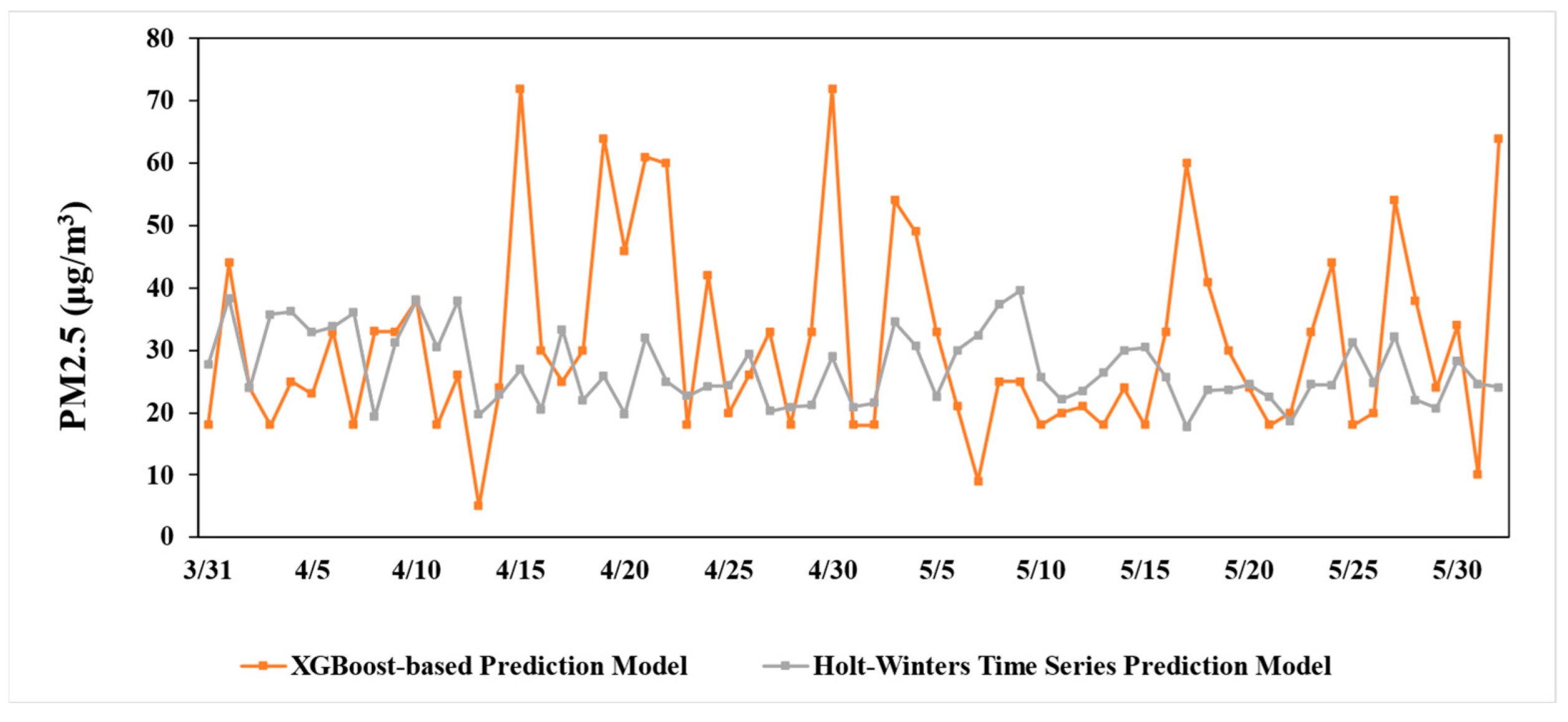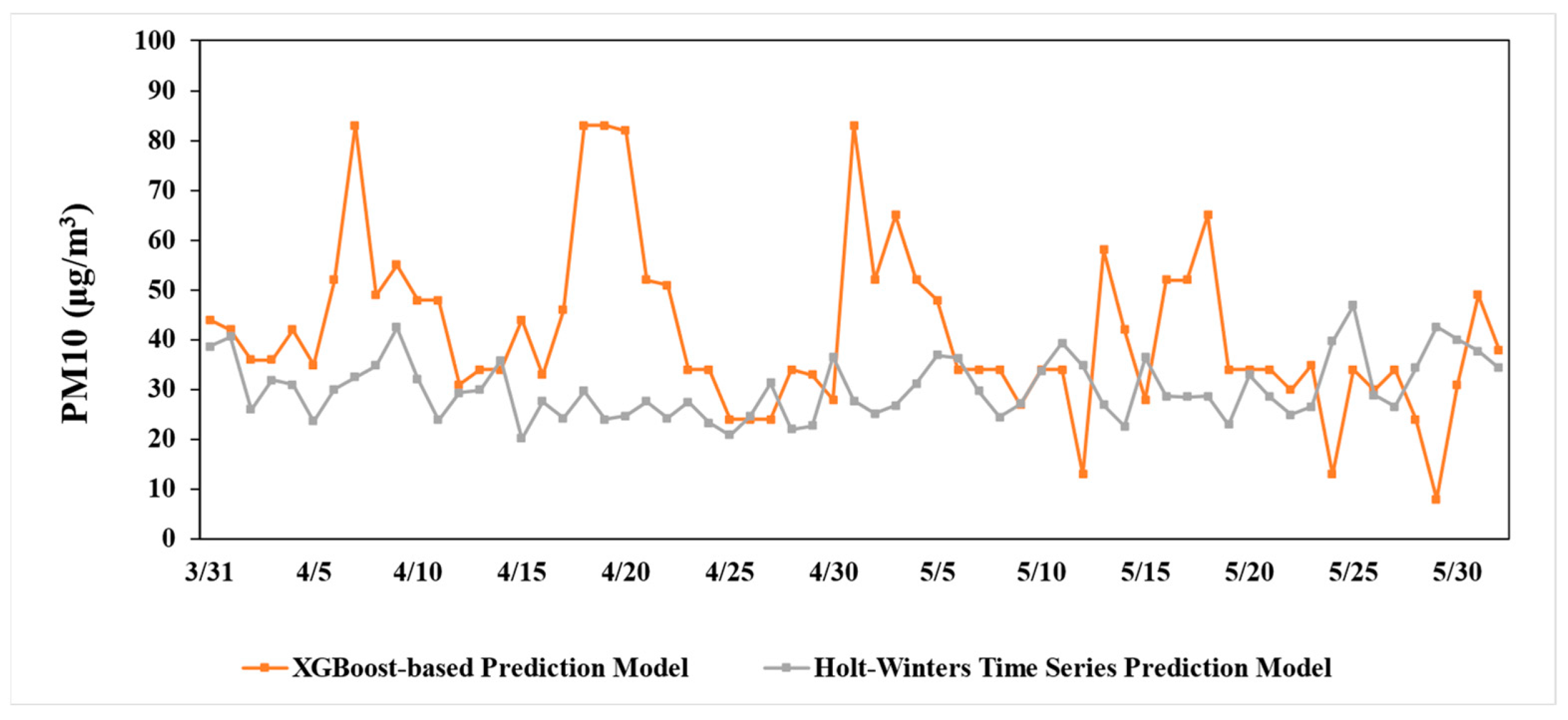1. Introduction
The Yangtze River Delta, as one of the four source areas of heavy haze events in China, has led to considerable air pollution problems over the past few decades due to its rapid economic development and urbanization [
1,
2]. During the past three years from 2020 to 2022, some social distancing measures were adopted to control the COVID-19 epidemic in China, such as movement restrictions, the prohibition of public meetings, the shutdown of schools and public places, isolation, and quarantine [
3]. These restrictions have significantly reduced anthropogenic emissions and prevented severe air pollution incidents in the Yangtze River Delta [
4], including the reduced emissions from public and private vehicle transport [
5]. Besides, some other major social events associated with the air pollution control measures, such as the Asia-Pacific Economic Cooperation (APEC) meeting in 2014 and the Victory Day parade of China in 2015, have demonstrated the positive effects of air pollution control measures [
6]. A case study also indicated that Guangzhou’s ambient air quality was significantly improved in 2016 after the implementation of a series of air pollution control measures in Guangzhou and the surrounding cities from 2014 to 2016 [
7].
Many countries have adopted closure measures during the COVID-19 epidemic period which control carbon emissions by sacrificing international shipping et al. and were mostly reported to have improved the local air quality [
8,
9,
10]. As vehicle emissions and industrial productions are the main sources of PM
2.5 and PM
10 air pollution, these pollution sources were controlled by the safety measures adopted for the prevention of COVID-19. The impact of restriction policies for the COVID-19 pandemic on air quality varies considerably between countries depending on their different geographical, economic, industrial, and social characteristics [
11]. By comparing the emission changes of the main pollutants in different regions of the world during the first six months of 2020, the eastern regions of China have the largest decrease in total emissions in February [
4,
12]. Research has shown that the concentrations of PM
10 decreased by 75% during the lockdown in Salé City (Morocco) compared to PM
10 in the normal period [
13], and the same value decreased by 18% for PM
10 in Portugal [
14]. As for the reduction of PM
2.5, the reports showed that the concentrations of PM
2.5 decreased 76.5% in Malaysia, 58% in Spain, 53.1% in Delhi, and 53.1% in Tehran [
9]. In addition, a reduction of 29.8% in PM
2.5 was found during the partial lockdown period in São Paulo state, Brazil [
15]. In the United States, PM
2.5 declined in urban counties with early closed businesses [
16]. In Wuhan, China, the concentrations of PM
2.5 and PM
10 in the lockdown period declined by 41.2% and 33.1%, respectively, compared to the pre-COVID-19 period [
17]. Besides, reductions in surface PM
2.5 and PM
10 were reported in six mega-cities in India during the lockdown period [
18,
19]. In 2020, PM concentrations at the traffic and background stations are on average 15% and 13.4% lower than in the reference period in Wrocław, Poland [
20]. In contrast, in Italy, no decrease in particulate matter (PM
10 or PM
2.5) was observed during the first phase of the COVID-19 epidemic [
21] and Few sites (2–3 out of 16) experienced statistically significant drops in PM
2.5 in Ontario, Canada [
22].
However, most of the available studies on outbreak control measures and environmental pollutant levels have yet to quantify the effects of meteorological changes on air pollutant levels during the COVID-19 pandemic around the world, which would lead to an overestimation or underestimation of the impact of COVID-19 lockdown measures on air pollution levels. In general, meteorological factors are of special importance in affecting the regional air quality in China [
1,
23,
24,
25,
26]. Meteorological conditions may be a determining factor in the occurrence of air pollution if the emissions of air pollutants in a region are essentially stable over a certain period [
25]. Many meteorological factors, such as wind speed, wind force, temperature, precipitation, and humidity, also significantly affect air pollution levels [
27,
28,
29]. The meteorological contribution to PM
2.5 levels ranged from −4.8% to 4.3% in the Yangtze River Delta region [
30]. The PM
10 concentration is negatively correlated with the relative humidity and temperature [
31]. The correlations between PM and NO
2 and between PM and SO
2 were moderate, while the correlations between PM and CO and between PM and O
3 were weak and unstable, respectively [
32]. Unfavorable meteorological conditions can offset the positive environmental impacts of closure measures; one report stated that control measures reduced PM
2.5 in Beijing by 12 µg/m
3. In comparison, meteorological forcing increased PM
2.5 by 30 µg/m
3, resulting in an increase in PM
2.5 levels during the closure period [
28]. In Hubei Province, China, which had the highest number of confirmed pneumonia cases in February 2020, the impact of total emissions reductions (72%) significantly outweighed the proportion of meteorologically driven PM
2.5 increases (13%) [
21]. The average PM
2.5 concentration in the Singapore region decreased by 19% when the effect of meteorological parameters was taken into account; this decrease was lower than the decrease observed when the effect of meteorological parameters was not taken into account (29%) [
33].
Although individual studies have incorporated meteorological parameters’ effects when assessing the impacts of COVID-19 on NO
2 and PM
2.5 pollutant levels [
33], the machine-learning methods applied in those studies are inferior to XGBoost models in terms of their predictive accuracy [
34,
35]. XGBoost, as a typically integrated algorithm, can be executed efficiently using fewer resources [
36]. Moreover, the XGBoost model combines hourly predictions with near-surface measurements of air pollutants and meteorological conditions to estimate daily PM
2.5 concentrations in Shanghai, China, with improved model correlation coefficients of 50–100% and reduced standard deviations of 14–24 µg/m
3 compared to the WRF-Chem model [
37]. In addition to using meteorological data, air quality standard data such as SO
2, NO
X, and O
3 data are utilized in the XGBoost algorithm to model the atmospheric PM
10 concentrations [
38].
Environmental factors play an important role in the spread of coronavirus disease 2019 (COVID-19) [
39]. A comprehensive crisis management strategy for pandemic threats must also be based on environmental and socioeconomic factors and new technologies, not just on medically relevant parameters [
40]. To gain experience that can be used to prevent future pandemic threats and to avoid overestimating or underestimating the impact of the COVID-19 outbreak on air pollution, this study used meteorological parameters (the mean temperature, dew point, visibility, and wind speed) and the concentrations of the remaining air pollutants to estimate the level of PM in the air during the COVID-19 outbreak. In addition, to account for the unpredictability of the lockdown measurements and increase the comparability of the results, this study examined trends of air pollutant concentrations from 2020 to 2022 (i.e., following the COVID-19 epidemic), as opposed to limiting the analysis to a predetermined lockdown period. We also compare the changes in air pollution levels in Shanghai during the lockout period (31 March to 1 June) in each year between 2015 and 2022 to provide a more comprehensive understanding of the effects of the novel coronavirus on air pollution.
4. Conclusions
This study investigated the ambient air quality changes in Shanghai during the COVID-19 lockdown period. Firstly, by analyzing the air quality during the study period, it was found that the proportion of days with good air quality in the three years of COVID-19 were increased year by year, with 41.27%, 65.08%, and 71.43% in 2020, 2021, and 2022, respectively. Then, based on the proposed XGBoost-based time series prediction model, the concentrations of PM2.5 and PM10 are predicted with the assumption that no COVID-19 lockdown measures were adopted. Thus, by comparing the actual observations during the COVID-19 lockdown period with predicted values, the concentrations of PM2.5 and PM10 were totally reduced by 60.81% and 43.12% in COVID-19 lockdown period (from 31 March to 1 June 2022). Furthermore, in terms of the predicted results without considering meteorological factors, the concentrations of PM2.5 and PM10 during the lockdown period were reduced by 50.20% and 19.06%, respectively, compared to the predicted values during the non-lockdown period. These indicate that the epidemic containment measures have had a positive impact on air quality.
To sum up, this study mainly provides three contributions: (1) quantified the continuous air quality changes and compared air pollution levels before and during the COVID-19 lockdown period in Shanghai; (2) comprehensively utilized the meteorological factors and air pollutant data to predict the concentration of PM in Shanghai during COVID-19 lockdown period in 2022, which has avoided the underestimation of the positive impact of COVID-19 lockdown measures on air quality by considering the meteorological factors; (3) Under the most basic conditions of life, the impact of human activity restrictions on PM provides data support for the future government to formulate environmental governance measures.
However, this paper is limited in some respects. In our future studies, we will try to use larger amounts of PM2.5 and PM10 data in more regions for better model performance. In this work, we only studied the changes in air quality before and during the COVID-19 lockdown period, except for this, our future studies will focus on the air quality changes before, during, and after the lockdown period. Furthermore, we did not consider the variations of PM2.5 or PM10 with specific human factors such as mobility, industry, manufacturing, or residential activity due to the lack of data. Therefore, our future studies will try to investigate correlations between the variations of PM2.5, PM10 and the specific anthropogenic factors.
